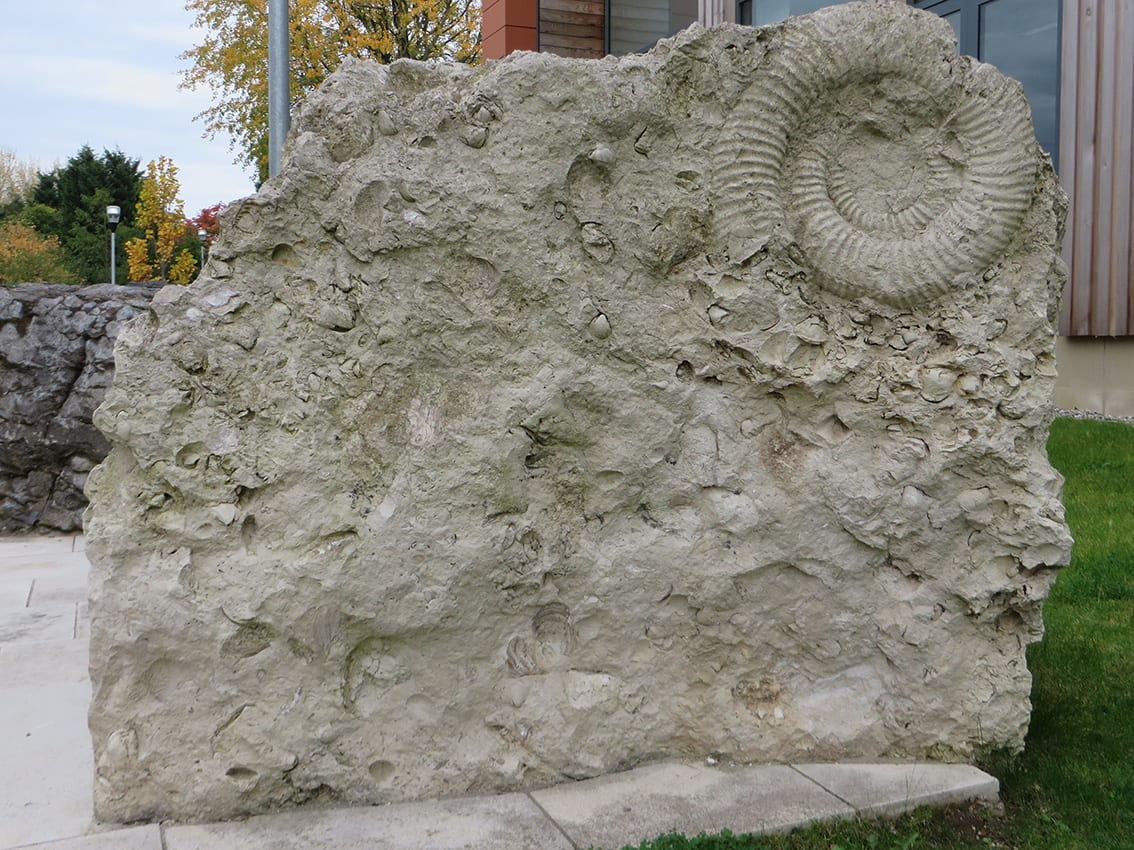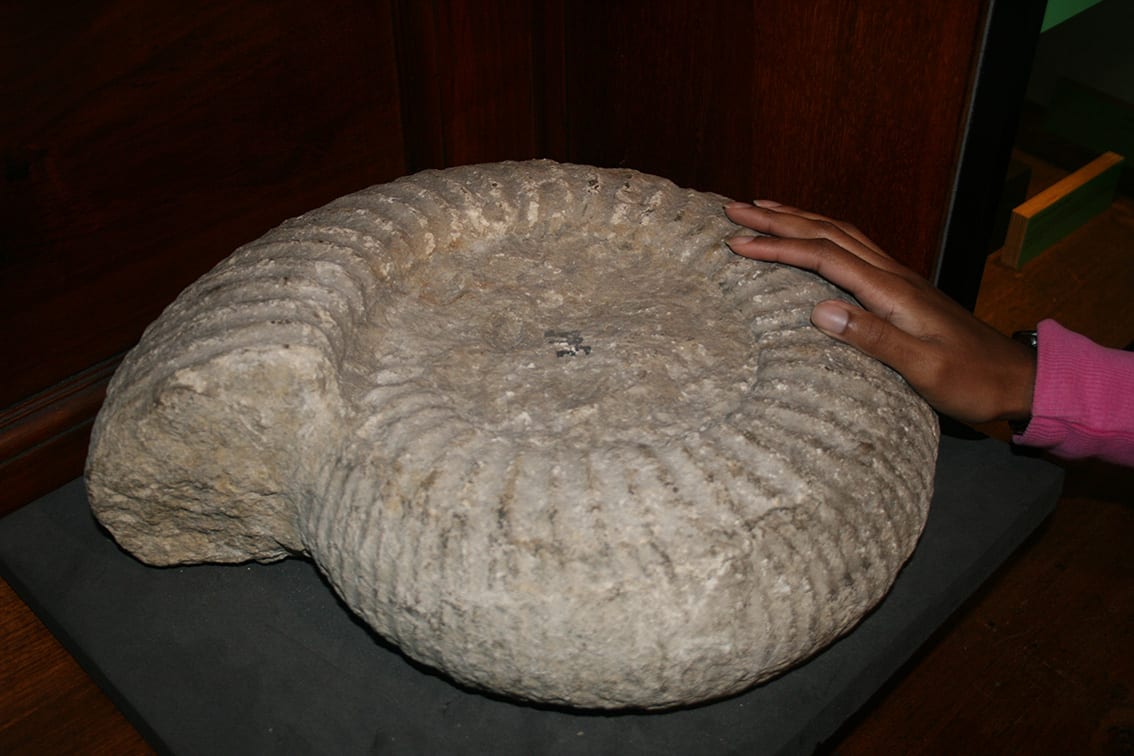I am once again delighted to be invited to write a guest blog for UCL’s Grant Museum of Zoology, and this one is about the extraordinarily large ammonites encountered in Portland Limestone. As avid readers of former Grant Musuem Curator Mark Carnall’s ‘cephalopod column’ in The Guardian will already be aware, cephalopods are a group of marine molluscs and amongst them live and lived the giants of the invertebrate world. Represented today by octopuses, squids, cuttlefishes and nautiluses, and extinct taxa represented by ammonoids and belemnoids, cephalopods have been a dominant invertebrate species in our seas since the Ordovician, 480 million years ago.
We have all heard of the giant squid, the somewhat shadowy and rarely observed Architeuthis dux which can reach lengths of up to 13 m, but this is not the only example of gigantism in cephalopods. Indeed, it is something that occurs regularly in this group throughout the fossil record. Although evidence exists for fossilised giant squid, these are rare as the soft-bodied animals do not preserve well. However nautiloids, ammonoids and belemnoids with their hard shells do preserve very well.
Gigantism is defined when a species is significantly larger than is normal for related animals. Your average ammonite would fit neatly on the palm of your hand, or maybe be as big as a side plate. The Late Jurassic ammonites of the Tithonian stage (152-145 million years ago) grew up to 1.5 metres diameter. These beasts swam in tropical seas and are known mainly from the Portlandian strata of Dorset and NW Europe and from the age-equivalent Volgian strata of European Russia.
UCL is built from Portland Stone, a limestone formed in tropical seas in the Tithonian around 145 million years ago and quarried today from the Isle of Portland in Dorset. The sandy Portland seafloor was colonised by small reefs of coralline algae and oyster shells, and around these swam ammonites, which were the prey of marine reptiles such as ichthyosaurs. The ammonites of the Portland Seas were enormous Dorsoplanitiae macromorphs, some more than 1 m diameter. They have names that live up to their size; Titanites giganteus and the less common Titanites anguiformes (‘anguiformes’ means ‘dragon-like’).
The picture below shows a block of Portland Stone Whitbed in the British Geological Survey’s Geological Walk at their Keyworth offices, with a nice specimen of Titanites from Inmosthay Quarry on the Isle of Portland.


Here in the Grant Museum is a ‘small’, fossil Titanites giganteus, perhaps a juvenile or an incomplete specimen, around 40 cm diameter (see top). Although common in the Portland Stone, Titanites sp. ammonites are rarely seen in the building stones, mainly because quarrymen kept them as souvenirs (there are many to be seen in the gardens on the Isle of Portland) or to sell to collectors and museums.
To give you some idea of how special it is to find a giant ammonite in Portland Stone, I have studied what feels like thousands of buildings in Portland Stone throughout London and further afield and have only ever spotted three Titanites sp. ammonites in all the vast acres of stone I have looked at. However one of these rare examples can be spotted on UCL’s campus. Take a walk around UCL and visit the porch of the Slade School of Fine Art at the north end of the Front Quad. Here in the paving are a few sections of preserved whorls, each one is a slab through the same fossil. This fossil would have been around the same size as the specimen in the Grant Museum. Hundreds of people walk over it every day and never notice it.
The other two examples I am aware of are at 4, Millbank and on the steps of the Grosvenor House Hotel’s ballroom on Park Lane (below).

 Why did these ammonites become so big? Gigantism in species is not well understood nor are the environmental driving factors which may promote it. It has been linked to high oxygen levels. While this might explain the enormous insects of the Carboniferous forests, this theory works less well for marine creatures. What is certain is that the late Jurassic was a time of geological change. It was a ‘Greenhouse world’ with high sea levels – and certainly the 1.5 m diameter of Titanites ammonites tells us that they could not live in very shallow waters, they would have needed a minimum of 2-3 m water depth. It was also a time during which there was a new configuration of tectonic plates, with the end of the first phase of the break-up of the Pangaea Supercontinent. This had led to the formation of a new seaway – Tethys – that could link Europe to what is now Central Russia. It is hoped that future work on the ammonite faunas of these regions may go some way to answer some of these questions.
Why did these ammonites become so big? Gigantism in species is not well understood nor are the environmental driving factors which may promote it. It has been linked to high oxygen levels. While this might explain the enormous insects of the Carboniferous forests, this theory works less well for marine creatures. What is certain is that the late Jurassic was a time of geological change. It was a ‘Greenhouse world’ with high sea levels – and certainly the 1.5 m diameter of Titanites ammonites tells us that they could not live in very shallow waters, they would have needed a minimum of 2-3 m water depth. It was also a time during which there was a new configuration of tectonic plates, with the end of the first phase of the break-up of the Pangaea Supercontinent. This had led to the formation of a new seaway – Tethys – that could link Europe to what is now Central Russia. It is hoped that future work on the ammonite faunas of these regions may go some way to answer some of these questions.
You can also find the locations of London’s Titanites on London Pavement Geology at these links:
Many thanks to Jack Ashby and Nadine Gabriel for assistance, viewing and scale.
References
Dr Ruth Siddall is a UCL Geologist, Geoarchaeologist, Urban Geologist and UCL Student Mediator.

